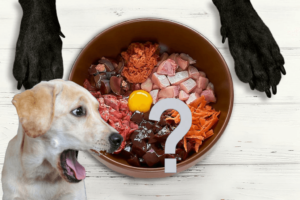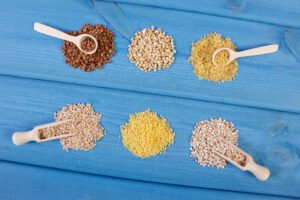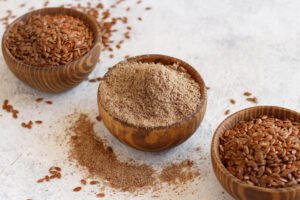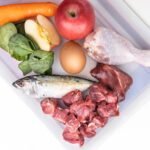Embracing homemade dog food recipes offers a delightful way to ensure your furry friend enjoys a balanced, nutritious diet, filled with love and care. Each recipe mentioned here has been crafted to provide a variety of benefits, catering to the diverse nutritional needs and taste preferences of dogs. However, it’s crucial to remember that these recipes are a guide and should be adapted to meet the specific health requirements of your individual pet. Always consult with a veterinarian or canine nutritionist before making significant changes to your dog’s diet to ensure they receive all the necessary nutrients for a healthy, vibrant life.
Tips for Homemade Dog Food Preparation
- Balance Over Time: It’s important to achieve nutritional balance over the course of several meals, not necessarily in every single dish.
- Protein Rotation: Rotate between different protein sources to provide a spectrum of amino acids and reduce the risk of developing allergies.
- Cooking Methods: Opt for steaming or boiling vegetables to preserve their nutritional value and ensure they are digestible for your dog.
- Supplementation: Depending on your dog’s health needs, you might need to add specific supplements to their diet to ensure they’re getting a complete nutritional profile. This could include vitamins, minerals, or specific fatty acids like omega-3s from fish oil.
Transitioning to Homemade Dog Food
- Gradual Shift: When introducing homemade meals, start by mixing them with your dog’s current food, gradually increasing the homemade portion over time.
- Monitor Health: Keep an eye on your dog’s energy levels, coat health, weight, and overall well-being to gauge how well they’re adapting to the new diet.
Creating homemade dog food can be a rewarding way to cater to your pet’s nutritional needs, offering them a diet made with love and care. Below are 10 homemade dog food recipes designed to provide balanced nutrition, packed with flavors your dog will love. Always consult with your veterinarian before introducing new foods into your dog’s diet, especially if they have specific health concerns or dietary needs.
1. Chicken & Rice Comfort Food
- 1½ cups brown rice
- 3 pounds chicken thighs, skinless
- 3 cups chopped spinach
- 2 carrots, shredded
- 1 zucchini, shredded
- ½ cup peas, canned or frozen
- 4 cups water
Instructions: Cook the rice as per instructions. In a large pot, boil the chicken thighs in water until fully cooked, then remove and shred. Into the same water, add chopped vegetables and cook until soft. Combine with rice, mix well, and let cool before serving.
2. Beef & Veggie Crockpot Creation
- 2½ pounds ground beef
- 1½ cups brown rice
- 1 (15-ounce) can kidney beans, drained and rinsed
- 1½ cups chopped butternut squash
- 1½ cups diced carrots
- ½ cup peas, frozen or canned
Instructions: Stir in ground beef, brown rice, kidney beans, squash, carrots, and peas with 4 cups of water in a slow cooker. Cook on low for 5 to 6 hours.
3. Turkey and Whole Grain Delight
- 3 pounds ground turkey
- 1 cup quinoa
- 3 cups chopped baby spinach
- 2 carrots, coarsely chopped
- 1 zucchini, coarsely chopped
- Olive oil
Instructions: Cook quinoa according to the package. Sauté the ground turkey in olive oil until cooked, then mix with the quinoa. Steam the vegetables until soft and combine everything. Cool before serving.
4. Salmon-Sweet Potato Special
- 2 salmon fillets
- 1 sweet potato, cubed
- 2 tablespoons coconut oil
- 1 apple, cored and cubed
- 1 cup kale, chopped
Instructions: Bake salmon at 375°F for 20 minutes. Sauté sweet potatoes and apples in coconut oil, then add kale until wilted. Flake the salmon and mix with the sautéed mixture.
5. Pork and Barley Bowl
- 2½ pounds pork shoulder
- 1 cup barley
- 1 sweet potato, cubed
- 1 apple, cubed
- 1 cup spinach
Instructions: Slow cook the pork shoulder until tender. Cook barley as directed. Steam sweet potato and apple until tender, and lightly sauté spinach. Shred pork, mix with barley, vegetables, and apple.
6. Veggie Fusion with Beef
- 2½ pounds lean ground beef
- 1½ cups brown rice
- 1 (15-ounce) can kidney beans, rinsed
- 1 cup chopped carrots
- ½ cup peas
- 1 cup chopped butternut squash
Instructions: Cook rice as instructed. Brown the ground beef in a pan. Steam or boil carrots, peas, and squash until soft. Combine all ingredients and cool before serving.
7. Lamb & Lentil Stew
- 2 pounds ground lamb
- 1 cup lentils
- 1 cup chopped zucchini
- ½ cup peas
- 2 carrots, chopped
Instructions: Cook lentils as directed. Brown the lamb, then add lentils, zucchini, peas, and carrots with enough water to cover. Simmer until veggies are tender.
8. Doggie Chicken Soup
- 3 boneless chicken breasts
- 1 cup chopped carrots
- 1 cup green beans
- 1 cup diced potatoes
- 4 cups chicken broth
Instructions: Boil chicken until cooked and shred. In a pot, combine chicken broth, chicken, and vegetables. Simmer until the vegetables are tender.
9. Egg & Veggie Breakfast Scramble
- 3 eggs
- 1 tablespoon olive oil
- ½ cup diced zucchini
- ½ cup diced bell peppers
- ¼ cup shredded cheese (optional)
Instructions: Scramble the eggs in olive oil, adding in the vegetables until fully cooked. Sprinkle cheese on top while hot.
10. Lean Beef Veggie Mix
- 2½ pounds lean ground beef
- 1½ cups cooked millet
- 1 cup chopped kale
- 1 cup grated zucchini
- 1 carrot, grated
Instructions: Cook millet as per instructions. Brown the ground beef, then mix with cooked millet and steamed kale, grated zucchini, and carrot.
Each of these recipes can be adjusted according to your dog’s size, age, and nutritional requirements. Remember to introduce new foods gradually and monitor your dog’s reaction. These homemade meals can provide a welcome variation to your dog’s diet and contribute to their overall health and happiness.
Final Thoughts
Feeding your dog a homemade diet can be incredibly rewarding, offering a pathway to enhanced health and wellness through carefully selected, natural ingredients. As you embark on this journey, remember the importance of variety, balance, and consultation with veterinary professionals. By tailoring these recipes to your dog’s specific needs and monitoring their response, you can provide them with a diet that not only satisfies their taste buds but also supports their health and happiness.

























